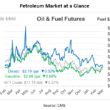The Coronavirus will accelerate the digitalisation of the media marketplace, especially in publishing. With many consumers confined to their homes, we should expect an increasing number of newspapers and magazines to go all-digital.
It might almost become something of a catch-up for print-centric media which has watched music and movie consumers move from pay-per-instalment models (such as Apple’s iTunes) to all-you-can-eat subscription services like Netflix and Spotify.
Retail sales of publications are suffering at precisely the time consumers are spending more time (and money) online searching for information, education and entertainment. Many readers (including even those who had already stopped buying printed magazines) will be rediscovering digital versions of media brands they had forgotten about. In the midst of horrific crisis, that is the opportunity for publishers.
Magazines might especially expect to benefit, not least because of the long shelf-life of their content and the “fit” with tablet media. In the UK, further impetus has been created, coincidentally, by the government’s pre-crisis decision this month to scrap the VAT (sales tax) that had long been applied to digital but not to print versions of newspapers and magazines.
UK publishers could almost not believe their luck after years of lobbying and, indeed, also campaigning to prevent the tax being imposed on print as well as digital. It’s a fillip for Readly International, the eight-year-old Swedish company which is Europe’s largest ‘all you can read’ digital magazine provider.
Readly partners with 800 publishers worldwide in providing digital access to more than 5,000 magazine brands. It has operations in eight European markets and the US, and is available in 50 countries and 16 languages. Last year, it distributed more than 120k issues of magazines that were read 83m times. It’s been a high-growth eight years during which the service has become an increasingly important source of revenue for magazine publishers, especially in Germany, the UK and Sweden.
Initially, the appeal to publishers was as a welcome source of ancillary revenue for magazine brands whose print sales had been falling for more than a decade. After all, the deal involved publishers in nothing more than providing a PDF of each issue to Readly. In return, they received fees geared to the length of time that subscribers spent reading each of the brands. Publishers receive more than 50% of the Readly subscriptions revenue and get a wealth of data insights about their audience. And the readership figures can be included in ABC circulation audits.
The growth of ‘all you can read’ is evident from Readly’s stats which show an average reading time per user of 6.9 hours per month, in sessions averaging 21 minutes. For many magazine brands, this compares with the time spent reading print versions. But it gets better. Some 8% of all the titles read by UK users are foreign and 16% of all titles read by UK users are back issues. So, although Readly’s UK audience is dominated by 40-60 year old Brits, it actually reaches all parts of the market and – and gets new audiences for magazines. So, most of the revenue publishers get from these services really is “new” money.
Readly appeals to subscribers for many reasons, presumably including:
- Unlimited access to large numbers of magazines for a low monthly fee (£7.99 in the UK)
- Realistic magazine feel with zoom, bookmarking and favourite functions
- Daily additions of new, downloadable issues
- Quick registration and availability across multiple devices simultaneously
For publishers, it means:
- A revenue share with no investment required
- Access to more readers to help support advertising revenue
- Advanced analytics
- Worldwide reach
In 2018, Readly increased its revenue by 54% to £17m, producing an investment loss of £9.5m. Earlier this month, the company was in the top half of the FT 1000 list of Europe’s fastest-growing companies on the back of its 69% CAGR in the past three years. The company was also in the top 10 of Deloitte Global’s Technology Fast 500 rankings for EMEA.
That 2018 revenue was an increase of 54% on the previous year for the company that wants to be the Spotify of magazines – and not just because it is also a Swedish digital startup.
The Readly story began in more tranquil times when digital entrepreneur Joel Wikell was on a family holiday in Cyprus. After reading the magazines he had brought with him over and over again and realising that the streaming music never dried up, he dreamt of an app with unlimited access to digital magazine feeds. The first string of code was written after the summer by developers in Växjö, in southern Sweden. Readly was launched in 2013.
Last year, the company completed a $16.8m investment round, led by the Third Swedish National Pension Fund, London-based Zouk Capital, and Swedbank Robur. with participation from existing and new investors. This brings the total investment to $29.9m.
Readly only provides magazines for its subscribers, by contrast with Apple News and others which also target newspapers. CEO Maria Hedengren told the Financial Times: “Apple has a lot of fans – I think you have to be paranoid about all kinds of competition. But look how successful Spotify has been in competition with Apple Music. Having a player like Apple entering the industry also tells you how interesting the future is.”
The real keys to Readly’s competitiveness are its specialisation in consumer magazines, its technology and continuing innovation. Recent developments include ‘Readly Articles’, individual features which help readers to sample magazines they may not know. Over time, you might expect some kind of grouping of special interest content and, perhaps even the ability to search right across the magazine portfolio. It is clear that there is substantial scope for pointing readers to magazines and content that matches their interests.
In some ways, the $70bn worldwide magazine industry, which is still four times the size of the global recorded music industry, is becoming much more interesting. The digital component has been estimated at $4bn, much of which are ancillary editions produced by publishers themselves. Over the past four years, consumer magazine revenue CAGR has fallen by 3% but digital has grown by 17%.
Publishers increasingly regard ‘all you can read’ revenues as mainstream. Take, for example, Future’s T3 gadget magazine, in the UK. Its latest ABC circulation figure shows that 57% of the circulation is now digital but that 61% of the digital circulation (or 34% of the print and digital total) is now accounted for by ‘all you can read’.
Further, the UK free weekly Stylist recently put its digital edition (which has a subscription price) on Readly. How long will it be before a publisher launches a digital-only magazine exclusively on Readly? Perhaps some publishers, facing a worsening copy sales market, will scrap printed editions, go all-digital and generate all their readership revenue from ‘all you can read’? Unmistakeably, it has become core business for publishers everywhere.




